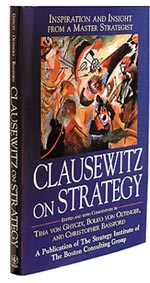Best Business Books: Strategy
Sun Tzu, von Clausewitz, Drucker, and other Master Warriors
(originally published by Booz & Company)In a memorable scene in the movie Patton, George C. Scott, in the title role, having successfully anticipated a German attack, shakes his fist at the advancing panzers and yells, “Rommel, you SOB, I’ve read your book!” Patton was a voracious reader, but the film’s producers were exercising a good deal of artistic license. The incident never happened, and there is no evidence that Rommel’s actions were predictable from his writings. In fact, Patton himself believed that all that could be learned from such works were “the eternal verities of leadership, morale, psychological effects and the difficulties and confusion which battle entails,” as he was quoted in Roger H. Nye’s The Patton Mind: The Professional Development of an Extraordinary Leader (1992).
Our modern concept of strategy emerged in Europe during the 18th century. Prior to that era, few writings on strategy existed other than those of the Chinese scholar Sun Tzu and the Italian philosopher Niccolò Machiavelli (1469-1527). Sun Tzu lived in the fourth century b.c., and his book The Art of War, which first appeared in Europe in the 1770s, is widely available today. He and others like him came to prominence in China as war changed from small-scale family feuds to battles between states. Bands of itinerant scholars — Sun Tzu may have been the first consultant to write a book — peddled practical solutions, promising wealth and power to any who would adopt their complex schemes. Those whose clients prospered could do very well. A variety of unpleasant fates awaited those whose advice failed. They were liable to be pickled alive, boiled in oil, or torn apart by chariots — courses of action that some managers might wish were still available to them today!
The Art of Generals
In Europe at the dawn of the Enlightenment, however, scholars of strategy had other objectives. Flush with their success at explaining physical phenomena using scientific principles, theorists started to examine the art of successful generals using similar frameworks. Their first great exponent of strategy was Frederick the Great of Prussia (1712–1786), whose small, well-drilled armies dominated Central Europe. Under King Frederick, military strategy took on a chesslike quality that allowed the early writers to bolster their arguments with mathematical formulas and elaborate geometrical designs. It must have been a huge shock to them when, at the end of the 18th century, armies built on the Prussian model were crushed by Napoleon’s massed columns. New scholars scrambled to explain this phenomenon and to revise their principles.
Two of these interpreters of Napoleon were hugely influential in the development of the concept of strategy. The name of the first, the Prussian general Karl von Clausewitz (1780–1831), is still well known in military circles; the name of the second, the Swiss-French general Antoine-Henri de Jomini (1779–1869), is scarcely remembered. It is a tribute to the durability of von Clausewitz’s ideas that his famous work On War has recently been excerpted for business readers. In Clausewitz on Strategy: Inspiration and Insight from a Master Strategist (2001), consultants Tiha von Ghyczy, Bolko von Oetinger, and Christopher Bassford have done a fine job of condensing von Clausewitz’s massive, unfinished book and have coupled it with an excellent commentary.
Von Clausewitz’s greatest value to business readers is probably his philosophical attitude to the relationship between theory and practice. For him, “real” war was a dynamic process. Every situation was unique, and no theoretical system could possibly tell a commander what to do: “Theory should ... guide [the future commander] in his process of self-education, but it should not accompany him to the battlefield.” Von Clausewitz argues that theory can help us focus on and summarize a topic — to understand history — but theory is inherently descriptive rather than prescriptive. The editors of this book suggest that he regarded principles as rungs on the ladder of imagination — aids to judgment and intuition in what was fundamentally a creative activity. In von Clausewitz’s view, principles could not be foundational pillars for action.
Von Clausewitz’s contemporary and rival Antoine-Henri de Jomini, on the other hand, saw actionable principles as central to any science of strategy. Regarded as the founder of the modern concept of strategy (as opposed to politics and tactics), de Jomini was the most widely read interpreter of Napoleon’s genius. He had a Platonist’s faith that behind the confusion and chaos of war were a few immutable scientific principles. The use of prescriptive principles appealed strongly to military educators, and de Jomini wrote for a wide audience that was eager to understand the “secret” of Napoleon’s success. Military ties between France and the fledgling United States had grown close during the War of Independence, and generations of West Point engineers had been trained by the “principles” approach. De Jomini’s influence remained strong in the military academies outside Germany until his reputation collapsed in the bloodbaths of the First World War. He had always insisted that his principles were independent of technology. In the American Civil War, when defenders had rifles instead of muskets, the Napoleonic principle of massed attack had proved merely expensive for the attacker. During the 1914–1918 war, against machine guns, it proved to be suicidal.
Schools of Strategy
The use of principles that simplify, reduce, and prescribe is an enduring feature of writings on business strategy. The writings of von Clausewitz and de Jomini outline a continuum between descriptive and prescriptive approaches to strategy. The Canadian management scholar Henry Mintzberg uses this distinction in Strategy Safari: A Guided Tour Through the Wilds of Strategic Management (1998), written with Bruce Ahlstrand and Joseph Lampel.
Mintzberg and his colleagues classify the voluminous writings on management strategy into 10 different “schools.” The first three of these, in order of their emergence, include the design school (mainly associated with Professor Ken Andrews and the Harvard Business School), the planning school, and the position school (of which Harvard’s Michael Porter is the best-known exponent). These schools are analytical and prescriptive. For example, H. Igor Ansoff’s Corporate Strategy: An Analytic Approach to Business Policy for Growth and Expansion (1965), the classic planning text, is full of complex flow diagrams. For those with the planning mind-set, strategy is formulated through a controlled, conscious, explicit process conducted by the CEO (and a group of planners) in a top-down, formal fashion and emerges fully formed from this process ready for implementation.
However, this classic planning approach to strategy suffered a deathblow in the 1970s when corporate icons like General Electric redeployed most of their specialist planning staffs. Ever since then, the rational, prescriptive views of the first three schools of strategy have been steadily augmented and supplanted by a number of descriptive approaches. Mintzberg sorts these into seven other schools, ranging from the entrepreneurial and the cognitive, to the learning, power, and cultural, to the environmental and configurational schools. The objective of these schools of strategy is not to instruct like de Jomini but to inspire the imagination like von Clausewitz.
An excellent example of the inspirational use of principles is Jim Collins’s Good to Great: Why Some Companies Make the Leap ... and Others Don’t (2001), the follow-up to his highly successful Built to Last: Successful Habits of Visionary Companies (1994), coauthored with Jerry I. Porras. (See “Climbing to Greatness with Jim Collins”) For Good to Great, Collins and his research team studied the financial records of 1,435 firms that belonged to the Fortune 500 from 1965 to 1995. They searched for firms that had produced mediocre (or worse) returns for 15 years and then had outperformed the market by a factor of three times or more for 15 years. They found only 11 such companies and labeled them “good to great.” This elite group consisted of Abbott Laboratories, Circuit City, Fannie Mae, Gillette, Kimberly-Clark, Kroger, Nucor, Philip Morris, Pitney Bowes, Walgreens, and Wells Fargo. Collins’s team then identified two comparison groups: a direct comparison group of companies in the same industries that had not improved their performance, and another group that had produced superior returns for a while, but had been unable to sustain that improvement. Collins and his team then studied the differences among the groups. Their findings are fascinating.
They found that good-to-great companies had leaders who combined a self-effacing humility with a fierce professional will to succeed rather than larger-than-life celebrity leaders, a feature of the comparison groups. In the good-to-great companies, these leaders first assembled a team of disciplined people and then, through disciplined thought and action, decided what should be done (as well as what they should stop doing) and how to do it (or stop it). “Who” came before “what” or “how.” The good-to-great group did not spend more time strategizing than did the others (all the firms had well-defined strategies), and they paid scant attention to managing change, motivating people, or creating alignment. With the right people, these issues seemed to just melt away.
A central finding of the study is that the good-to-great firms disciplined their thought with what Collins calls a Hedgehog Concept, named after writings by the Greek poet Archilochus about the hedgehog, who knows one big thing (as opposed to the fox, who knows many small things.) A Hedgehog Concept is a deep understanding that flows from the intersection of three circles:
1. What you can (and cannot) be the best in the world at
2. What drives your economic engine
3. What you care passionately about
Collins suggests that this understanding is not a one-time achievement, but an evolving product of an iterative process best conducted in leadership councils of the right people, who engage in dialogue and debate guided by the three factors.
Unsuspected Strategies
Iterative processes, discipline, and focus are also central features in The Strategy-Focused Organization: How Balanced Scorecard Companies Thrive in the New Business Environment (2001), the latest in the Balanced Scorecard (BSC) series of books from Harvard Business School Professor Robert S. Kaplan and consultant David P. Norton. The Balanced Scorecard began its life as an attempt to help corporations escape the short-term tyranny of financial measurement. It has now expanded into a strategic management system. “We do not claim to have made a science of strategy,” write the authors. “The formulation of strategy is an art and will always remain so. The description of strategy, however, should not be an art” (authors’ emphasis). The authors may be too modest, however, for it’s clear that when vision and strategy are communicated so that people throughout a firm can grasp them, it creates a favorable context that often leads to the emergence of new and unsuspected strategies. And, as we shall see, those contexts can be constructed systematically.
 Kaplan and Norton describe in detail how organizations in both the private and the public sectors have used the BSC to translate strategy into operational terms, align the organization with it, make strategy everyone’s everyday job, turn strategy into a continual process, and mobilize change through executive leadership. The authors’ criteria for success are far less stringent than those in Good to Great, but their list of firms is impressive (Fannie Mae is the only organization that appears in both books), and the stories are compelling. It’s refreshing to find a chapter on the pitfalls of introducing the Balanced Scorecard technique, supported by cases of where and how it went wrong. An obvious danger is that a BSC project can degenerate into a bureaucratic form-filling exercise, a fate experienced by so many management-by-objectives programs.
Kaplan and Norton describe in detail how organizations in both the private and the public sectors have used the BSC to translate strategy into operational terms, align the organization with it, make strategy everyone’s everyday job, turn strategy into a continual process, and mobilize change through executive leadership. The authors’ criteria for success are far less stringent than those in Good to Great, but their list of firms is impressive (Fannie Mae is the only organization that appears in both books), and the stories are compelling. It’s refreshing to find a chapter on the pitfalls of introducing the Balanced Scorecard technique, supported by cases of where and how it went wrong. An obvious danger is that a BSC project can degenerate into a bureaucratic form-filling exercise, a fate experienced by so many management-by-objectives programs.
The authors were at first surprised to learn that two of their most successful adopters were ex-Marine officers, considering that the military are often stereotyped as command-and-control freaks. But the best soldiers, like the most effective managers, understand that the purpose of measurement is not control over others but communication that leads to a decentralized self-control focused on a common cause — the implementation and, where necessary, the modification of strategy.
This theme of management by self-control has, of course, long been central to the writings of Peter F. Drucker. He stated it best nearly 30 years ago in his massive Management: Tasks, Responsibilities, Practices (1974). The ultimate objective of management, he argued, is to produce a “self-governing work community,” which requires productive work, feedback for self-control, and continuous learning. Perhaps this is why so much writing on management during the past decades reads like footnotes to Drucker.
The Myth of Excellence
Creative Destruction (2001), by consultants Richard N. Foster and Sarah Kaplan, casts new light on the organizational environments that produce superior performance. The subtitle of the book, Why Companies That Are Built to Last Underperform the Market — and How to Successfully Transform Them, summarizes their message. They use a custom-built database to track 1,008 companies in 15 industries from 1962 to 1998 and show that long-lived corporations typically underperform market averages as represented by the S&P 500. Thus the notion of excellence, of a corporation surviving indefinitely while producing superior returns, is revealed to be a myth. It’s the new entrants into an industry that produce superior returns and then usually go through an aging process accompanied by declining performance as they enter “cultural lock-in.” Thus markets produce better returns than corporations.
The authors suggest that creative destruction is necessary within corporations if they are to mimic the scale and pace of change of a marketplace. They cite the venture-capital firm Kleiner Perkins Caufield & Byers and buyout specialists Kohlberg Kravis Roberts & Co. as examples of organizations that create, operate, and trade in ways that encourage creative destruction. The example of the process within a single firm is drawn from the authors’ work with Johnson & Johnson, where they ran a series of corporate dialogues that resemble in spirit, if not in mechanical detail, the councils espoused by Jim Collins in Good to Great.
Foster and Kaplan’s significant contribution is the analysis that shows the existence of the process of creative destruction in the American economy and, in fact, shows that its pace is increasing. In the 1920s, a corporation on the S&P 500 could expect to be there for 60 years or more. Today that expectation is down to 20 years, and if the acceleration continues, it could be as little as 10 years by 2025. Such knowledge should concentrate the minds of senior managers wonderfully! Foster and Kaplan’s recommendations for how companies can avoid dropping from the S&P 500 are less detailed and compelling than those offered in Good to Great and The Strategy-Focused Organization, but one wonders whether any of them can do anything other than stave off the inevitable decline.
Harvard Business School Professor Clayton M. Christensen, in The Innovator’s Dilemma: When New Technologies Cause Great Firms to Fail (1997), has examined in detail why organizations seem incapable of reinventing themselves. (See “Clayton M. Christensen, The Thought Leader Interview”) He was fascinated by the experience of the computer disk-drive industry, where the leaders in one generation of drives seemed incapable of staying atop the market in the next generation. Smaller entrants who attacked from “underneath,” using what Christensen called “disruptive technology,” displaced the older players. Christensen has since regretted using the term and now prefers to talk about “disruptive business models,” for often the new technology was not radically different from the old. Rather, the differences lay in the resources, processes, and values required to exploit the new technology. Thus Christensen has outlined what is effectively a corporate process of maturation and aging whereby the strengths and relationships developed to exploit one situation turn out to be weaknesses and constraints in other contexts. Capability and disability are two sides of the same coin, and one is replaced by the other as contexts change.
All the current books cited above emphasize the implementation of strategy rather than its formulation, the topic that so preoccupied the early business writers on strategy. The separation between formulation and implementation always was an artificial one, done for pedagogic purposes only, or so its proponents claimed. Now practitioners are bringing the two together again. One feels that Napoleon would have approved of that. The great general disliked the word plan because of its connotations of fixed, unchanging design. Instead, he liked to talk about strategic “preparations.” And he believed to the end of his life that “The art of war is simple, everything is a matter of execution.” ![]()
| Authors
David K. Hurst, dhurst1046@aol.com David K. Hurst, a regular contributor to strategy+business, is the author of Learning from the Links: Mastering Management Using Lessons from Golf (Simon & Schuster Inc., Free Press, 2002). A speaker and writer on management, Mr. Hurst also wrote Crisis & Renewal: Meeting the Challenge of Organizational Change (Harvard Business School Press, 1995) and was a visiting scholar/practitioner at the Center for Creative Leadership in Greensboro, N.C., in 1998–99. His writing has appeared in Harvard Business Review, the Financial Times, and other leading business publications. |



